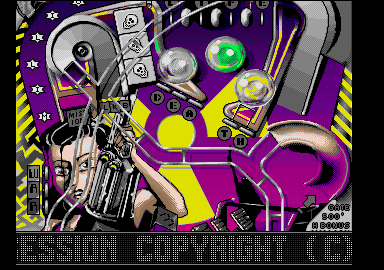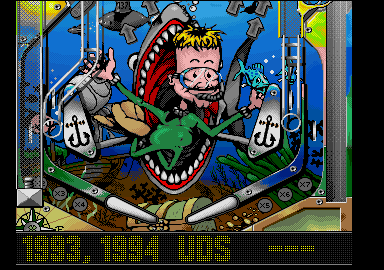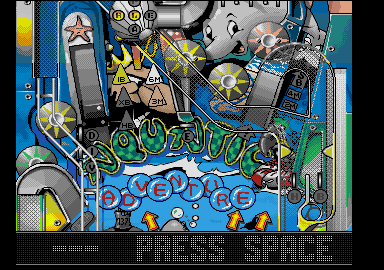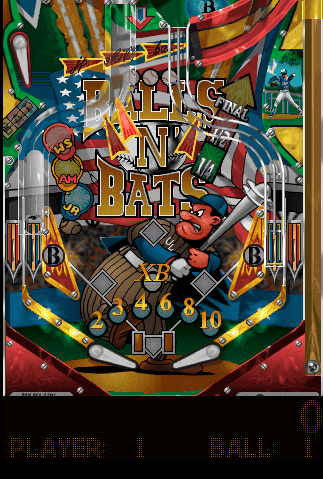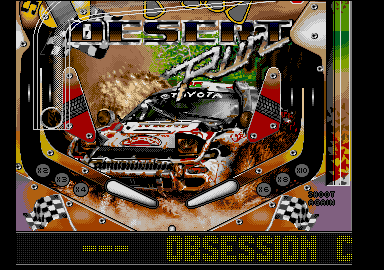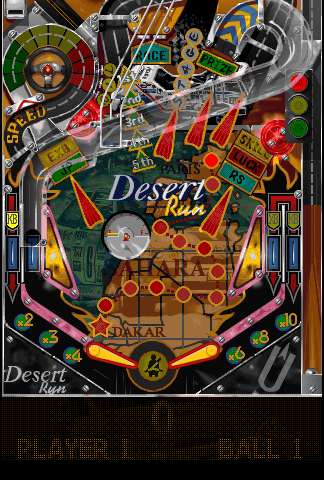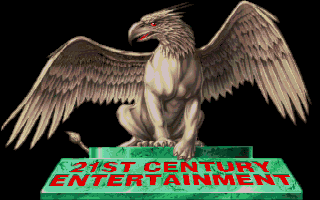
21st Century Pinball
|
Page 1: |
Page 2: |
Page 3: |
Page 4: |
Page 5: |
|
Page 6: |
Page 7: |
Page 8: |
This one's got a fairly interesting history to it. Obsession Pinball (also known simply as Obsession) was originally released in 1994 by an unheard-of company called Unique Development Sweden (UDS). The game was first put out for Atari STe platforms, and eventually enhanced and brought to Amiga, with no involvement whatsoever from 21st Century (though the game was picked up by them two years later and remade for MS-DOS machines). As a quick history lesson, the Atari STe was essentially an upgraded Atari ST, with support for a larger color palette, higher quality stereo sound (equivalent to the Amiga's famed "Paula" sound chip), and support for Atari's Jaguar gamepads without the use of an adapter, among other hardware-related enhancements.
It's really a surprise: this is UDS's first game, and yet it already stacks up to DICE's finest, especially in terms of the ball physics. Everything behaves just as you'd think it would. There's a good degree of randomness on the physics so you won't be reenacting the same game over and over. The tables are well designed and nice to look at, and UDS even threw in some nice graphical touches (like the rotating block that serves as the game's main menu). I should also mention that, unlike the previous several games, Obsession and Absolute Pinball both are set to five balls per game by default, as opposed to three, and the ball physics are much faster than in other sims, making this a very, very difficult game.
Aquatic Adventure
A neat underwater table where you're scuba-diving your way through the various bonuses. As with most pinball tables, most of the action takes place on the upper half of the table, though this table does also offer a Kickback feature and a skill shot. The bonuses strike quite a nice balance between being easy to figure out and hard to pull off - it's pretty obvious what most of the ramps do, but it's quite difficult to actually hit them with the ball.
X-ile Zone
This one's themed as a William Gibson-esque cyberpunk setting. The bonus modes typically involve eliminating targets (though it is never stated what these targets are, nor how they are eliminated) or shutting down security systems, and a moral theme is also vaguely hinted at with the drop, spot, and rollover targets spelling out WAR, LIFE, and DEATH. Overall, this table really only seems remarkable for its unique artwork; it doesn't play that interestingly...
Balls 'n' Bats
A baseball-themed table that happens to be fairly lenient with drains under the right circumstances. Hitting a certain target on the board will make the pitcher throw the ball towards your flippers, with the umpire very helpfully calling out what kind of pitch it is. Hitting the ball with your flipper and making it hit the right target scores you major points, while missing the ball just makes the pitcher try again until you've got three strikes, at which point the ball ends (and with three "strikes" per ball and five balls per game, this stretches games a while). While this table is probably the most baseball-accurate pinball table I've seen, I find that it is a little too generous with how many balls you're given, making games tend to drag on for a long time. The music also gets on my nerves.
Desert Run
Themed after the Paris-Dakar cross-country desert rally, you'll be managing not only the gas in your car, but also the money you use to pay for said gas. If you don't have gas, you can't use half of the bonus ramps, so it's pretty crucial to keep the car fueled up. You'll also generally score more points if you make sure you are in the lead (as you are technically supposed to be racing two other cars), which you can do by launching your ball into the "PLACE" ramp. Your position in the race automatically counts down over time, so you will need to continue hitting the Place ramp to keep ahead. Also, fuel doesn't last forever - if you can't hit the Pitstop ramp at the top of the table within several seconds of getting gas, you'll need to repeat the cycle over again. Getting money isn't that hard, though, as two of the ramps give generous amounts of cash for hitting them. What's rather frustrating, though, is that there is no indicator on screen for how much money you have (it all seems to be eaten at once when you refill your fuel), or whether you have fuel in your car, and the Place indicator isn't visible unless the camera is pointing at a higher portion of the table. The table artwork and music are pretty nifty, though, and the music was remixed for the Amiga Immortal series of music CD's by the original composer, Per Almered.
This game was originally released for the Atari STe, meeting a generous following, particularly to Atari ST users who wanted to show their Amiga-using "rivals" that they could do pinball just as well. UDS later brought the game to the Amiga, benefitting from the Amiga's extended range of colors compared to the STe, though interestingly they did not opt to use the AGA chipset. Despite this, the Amiga version does look a bit nicer than the STe version, but gameplay-wise, they're on about equal ground, and the soundtrack between Amiga and STe versions is, surprisingly, exactly the same. The STe version makes up for its relative lack of colors by using subtle dithering tricks, which are only really noticeable in X-ile Zone and Aquatic Adventure, and provide a grittier appearance on Desert Run and Balls 'n' Bats.
Quick Info:
|
Developer: |
|
|
Publisher: |
|
|
Genre: |
Obsession (Amiga)
Obsession (Amiga)
Obsession (Amiga)
Obsession (Amiga)
Obsession was proving very popular on its native Amiga and Atari computers, and 21st Century must have taken notice and wanted to expand the game to DOS-using audiences, so in 1996, Absolute Pinball was released. The table graphics got a severe overhaul, with a lot of color and detail added, more animations, an enhanced dot-matrix score display, and a new table (though at the expense of an older one). The finished product was renamed to Absolute Pinball and released on CD-ROM in 1996. They're almost completely different games, if you ignore the fact that the tables essentially play just the same as Obsession's, aside from a few physics tweaks. I personally think the flipper action feels a bit too stiff compared to the Amiga/STe version, but that's probably just me.
The three surviving Obsession tables got a number of upgrades and enhancements, while the new table, The Dream Factory, is added at the expense of Obsession's X-ile Zone table.
Aquatic Adventure
This table has a number of changes in the locations of ramps, additional video modes, and some radically different artwork. Most of the table seems to play about the same, though, outside of the added video modes, and some of the music also survived the conversion, though I believe the main table theme may be different.
Desert Run
It's really easy to earn extra balls on this table in the Absolute version: all you have to do is hit let the ball drop down the inner-right lane when the XB light is lit (made easier by the fact that the flipper buttons will change the lane lights), then shoot the Speed ramp. I don't know how I managed it, but I actually played a game that gave me 8 balls in total. The music in the Absolute version is peppy and catchy, though in major contrast to that of the Obsession version which is actually a little creepy and depressing. Numerous extra bonus modes were added to this version as well, and the act of getting gas and money is slightly simplified by the fact that you can now see what your fuel gauge says. Also, you no longer seem to have to worry about your position in the race, as although it can be increased, it doesn't seem to drop with time. Also new to the Absolute version is ball-locking, which can be triggered by hitting the two Race drop-targets and then landing the ball in the tunnel and flipping the ball at the correct time afterwards.
The Dream Factory
This new table is designed after good ol' Hollywood, circa 1950, where you are the director of your very own blockbuster film. Earn bonuses by drafting actors, attending parties, and actually shooting your film. It's actually really well laid out and scores somewhat highly. The actors all seem to be caricatures of real Hollywood actors like Clark Gable and Clint Eastwood. A lot of the ramp bonuses in this table depend on you making the same shot multiple times in a row, such as the "And once again!" upper flipper shot.
Balls 'n' Bats
This table probably received the fewest changes - a couple of additional video modes are added, such as the requirement of hitting the ball on screen when you hit the Home Run ramp followed by the red ramp using the upper level flipper. The music is identical to Obsession's, and the table artwork is almost the same as well. The upper level ramps were altered a bit to accommodate the new upper flipper, and the four lanes now spell "BEER" instead of "SAFE."
In addition to the new graphics, Absolute Pinball supports higher screen resolutions than the previous games. Setting the game into High Res mode will enable you to see more of the table at once, but since there isn't anything but the table on screen, the sides of the screen are taken up by black bars. This is no big deal if you're used to playing arcade ports, but it does seem kind of cheap, not to mention zooming out can be a little hard on the eyes if you're used to the close-up perspective of the older games. But this is all totally meaningless when you run the game in VESA Flip mode, which is essentially just like the Tate Mode you'll find in shmups like Ikaruga. Turn your monitor on its side, see the entire table with no need for distracting scrolling, and be more or less in pinball heaven.
Quick Info:
|
Developer: |
|
|
Publisher: |
|
|
Genre: |
Absolute Pinball (DOS)
Absolute Pinball (DOS)
Comparison Screenshots
|
Page 1: |
Page 2: |
Page 3: |
Page 4: |
Page 5: |
|
Page 6: |
Page 7: |
Page 8: |
